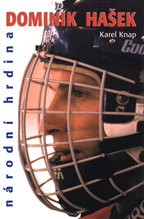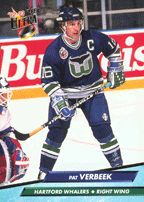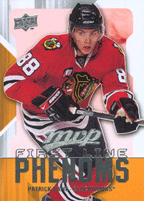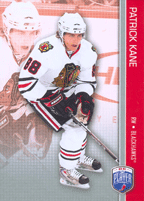| Patrick Kane — Biography | |||||
| bio | facts | what they say | my say | ||
Becoming a feared scorer in the National Hockey League takes a rare combination of skill, strength and confidence. And to do so before age 21 takes something even more special. Whatever that is—in Chicago, some say Mullet Power!—Patrick Kane has it in spades. What the Chicago right wing does not have is the imposing size of a Mats Sundin or Mario Lemieux. That makes Patrick’s goal production all the more remarkable. When the Blackhawks made him the top pick in the 2007 NHL draft, some joked they were literally building from the bottom up. Little did fans know they would be cheering—not jeering—Patrick as he led Chicago back to hockey’s promised land just three seasons later. This is his story…
| |
GROWING UP
Patrick T. Kane, Jr. was born on November 19, 1988 in Buffalo, New York. (Click here for a complete listing of today's sports birthdays.) He was the first of four children welcomed into the world by Donna and Kiki Kane. Patrick was followed by three sisters—Erica, Jessica and Jacqueline.
Patrick began his journey to hockey stardom at about the time he was able to tie his own skate laces. His ties to Buffalo hockey began even before that. Memorabilia collectors lucky enough to own a certain poster of Pat LaFontaine may notice a toddler sitting in his dad's lap in the background. That’s Patrick! He still has the poster hanging in his room.
Later, during the construction of Buffalo’s new arena, Patrick was photographed signing the last piece of steel to go into the Sabres’ future home. In the picture, he is wearing a Buffalo jersey with the name and number of young star Dominick Hasek. Years later, the photo faded only a little, Patrick posted his first NHL shoot-out goal, a game winner against the Detroit Red Wings. The goalie he beat? Hasek.
Patrick’s organized hockey started on the C-line in the mite division in Cazenovia, a suburb of Syracuse. It was there, along with the support and help of his father, that Patrick learned the fundamentals of skating, stick handling and the concept of the game. His skills improved as he got older, as did his dedication and passion.
As a family, the Kanes had made the decision to cultivate their son’s interest in hockey. For Kiki, the commitment became a seven-day-a-week job. He drove Patrick to as many as four rinks a day. In addition to the regular games, his dad chauffeured him to tryouts and paid the fees just to get his son on the ice. The tryouts were often in an upper age category, which not only gave Patrick familiarity with that level but also a chance to learn what it takes to be a better player. Many times, Kiki had no intention of having his son play for the team that was holding the tryouts.
Patrick’s skills began to improve. His advanced talents became apparent while playing in a summer league in Wheatfiled. In fact, Patrick scored so many goals that a group of parents became upset and petitioned league officials to bar nine-year-old. When Kiki spoke with the league, an offer for a full refund was made if Patrick played elsewhere. Father and son scouted a league for older players. They agreed that Patrick could handle the advancec competition.
Throughout his youth hockey days, Patrick was considered small. There were concerns and whispers that his size might hinder his success when checking began. Patrick had been roughed up bumped and shadowed on every shift in Mite hockey. But the physical play didn't faze him. At times, he seemed to thrive on it.
From Mites to Bantams, Patrick played on four teams—CYPA, West Seneca, the Buffalo Regals and the Buffalo (Depew) Saints. Going from rink to rink and team to team, the Kanes were entrenched in a whirlwind hockey existence. Patrick was skating in upwards of 300 games a year.
Patrick’s commitment to hockey was matched by his parent’s devotion to his success. His mother and father supported him as long as he continued to enjoy it. Kiki andDonna realized that there was a fine line between pushing him too hard and helping him cultivate his obvious gifts. That fine line became even thinner when, at age 14, he was approached by the Honeybaked AAA Midget team, in Detroit.
ON THE RISE
For the Kanes, the offer from Honeybaked was the chance of a lifetime. Patrick would learn the game playing for a respected major Midget team and potentially earn a college scholarship. Those pros outweighed the major con before them—Patrick would have to move to Michigan.
But when the family found out that Patrick would be living with Pat Verbeek, Honeybaked’s assistant coach and a former NHL All-Star, it helped tip the scales. Verbeek had played for five NHL teams—New Jersey Devils, Harford Whalers, New York Rangers, Dallas Stars and the Detroit Red Wings—scoring 533 goals over a career that spanned 21 seasons. He won the Stanley Cup with the Stars in 1999.
![]()
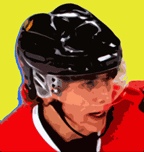
At 5-9, Verbeek had a lot in common with Patrick. Known as the "Little Ball of Hate" during his playing days, he had to scrap for every goal he scored. His grit and tenacity were characteritics that Patrick could emulate.
In August of 2002, Donna drove her son the 215 miles from Buffalo to Detroit. On the way, Patrick assured his mother that he’d be okay.
During his first few months in Detroit, Patrick went through tough times. At first he didn’t like the new environment. He was homesick and tired, but he slowly began to realize that each day he was getting closer to his dream of playing in the NHL. Patrick absorbed all he could. He learned a lot from the competition on the ice, the training off of it and the coaching staff, especially from Verbeek. He was often commended for his offensive game, but the issue of his size continued to linger.
Height and weight notwithstanding, Patrick’s focus and commitment did not go unnoticed by the hockey community. Who could ignore a 14-year-old that posts 83 goals and 160 points in 70 games?
The London Knights, an Ontario League Midget team, picked Patrick in the 5th round of the 2004 OHL draft. Patrick decided to turndown the Knights until the 2006-07 season, however, choosing instead to join the U.S. U-18 National Team Development Program. He spent two years under the tutelage and direction of the NTDP system and led the team in scoring. In 121 games, he recorded 172 points (90 goals, 82 assists), breaking Phil Kessel’s old scoring record.
In 2006, Patrick participated in his first international tournament as a member of the gold medal winning U-18 United States team. From there he was named to the American squad for the World Junior Hockey Championships. The U.S. came away with the bronze medal behind Canada and Russia. In seven games, Patrick had nine points (5 goals, 4 assists and a +2 rating) and was selected as one of top two stars in three contests. He was also named as one of the tournament’s Al-Stars along side teammate Erik Johnson and Canada’s Jonathan Toews.
Patrick’s performance had college hockey recruiters watching him closely. Powerhouse programs like Boston College and the University of Michigan offered scholarships, but hemade good on his commitment to the Knights. His belief was that London coach Dale Hunter, a former NHL All-Star and owner of the second-most penalty minutes in NHL history, would help him better prepare for life as a pro.
Another advantage of playing in the OHL was the number of games on the schedule. With the Knights, Patrick could expect to see twice as much ice time. He jioned the team for the beginning of the 2006-07 season. Hunter placed him on an unstoppable line with future NHL stars Sergei Kostitsyn and Sam Gagner. In all, they totaled 394 points, with Patrick tallying 145 points of his own. In doing so, he became only the second rookie in Knights’ history to reach 100 points. The first was Dave Simpson, who scored 155 points during the 1981-82 season.
Patrick’s 100th point for London was an ovation-evoking goal with 1:44 left in the third period of a tie game. After the crowd finished honoring him, they continued to cheer on their team to a sudden death victory.
As Patrick navigated his way up the hockey ranks, his relationship with his parents, especially his father, took a new direction. Kiki had become less of a hockey director and more of a fan. He sold his partnership in a Jeep dealership in order to drive to as many OHL games as weather permitted. For Kiki, being able to witness his son’s success was deeply satisfying.
At the end of the 2006-07 season, Patrick earned three OHL honors—the Eddie Powers Memorial Trophy for most goals scored in the season, the Emms Family Award for Rookie of the Year and the Jim Mahon Memorial Trophy for the highest scoring right winger. He was runner-up to John Tavares for the league’s MVP. Rumors began touting Patrick as a potential number one draft pick in the upcoming NHL draft. But his size continued to concern some critics.
The Blackhawks owned the first pick in ’07 and had a tough decision. Chicago GM Dale Tallon had begun to assemble a steady lineup, including Toews, acquired in the previous year’s draft. Back in 1980, the Blackhawks had been in a similar position. That year, they tabbed Denis Savard—a big-time scorer in the juniors around whom they built a competitive club. Savard was now the team’s head coach. He loved Patrick. So did Talon. The Blackhawks thumbed their noses at the naysayers and took Patrick with the top selection. After the announcement, Patrick hugged his parents and then found his grandfather. Donald Kane. At 83-years-old, he attended to the ceremonies despite recuperating from major heart surgery.
Patrick became one of five Blackhawks ever to be taken as a top-three overall pick. He joined Savard (1980), Eddie Olczyk (1984), Cam Barker (2004) and Toews (2006). He stood alone as being the first-ever overall pick to come out of Buffalo.
The photo ops didn’t end after the fanfare of the draft. Patrick was flown to Chicago. After meeting with the team, he went to Wrigley Field, where he threw the ceremonial first pitch and sang “Take me Out to the Ballgame” with Savard.
Patrick was eager to get on the ice and prove that he was ready to make the jump from junior hockey to the NHL. He prepared for training camp by working out as hard as he ever had in his life, packing on ten pounds of muscle.
Off the ice, Patrick got to know his new teammates better. He was invited to move in with fellow Buffaloan, Kevyn Adams, but chose to live in the basement apartment of assistant GM Stan Bowman. On the road, Patrick was paired with his linemate and team captain, Toews.
Patrick made his NHL debut on October 4 against the Minnesota Wild. The Blackhawks lost 1-0. Two days later, he scored his first NHL goal in the shootout against Hasek.
Patrick visited Buffalo for the first time as pro on December 15. Somewhere in the arena, his signature was still on a hunk of steel. Patrick’s presence drew nearly 1,000 fans to a pregame skate and ceremonial puck dropping that included his father and grandfather. That evening, a sellout crowd cheered Patrick when he drew the first penalty of the game—and later scored Chicago’s first and only goal. He was named as the third star of the contest. Again, the home crowd cheered.
With the Hawks playing solid hockey and Patrick’s 88 jersey selling like hotcakes, the team began to roll out a more aggressive marketing campaign—something that had been absent for years in Chicago. Fans who had stayed away in droves were now returning to the arena, and they were treated to a winning team for just the second time in a decade. The Blackhawks finished the year with 40 victories and just missed the playoffs. Patrick played in 82 games and scored 72 points (21 goals, 51 assists) to lead all rookies. When it came to vote for the Calder Memorial Trophy for rookie of the year, he beat out his teammate and buddy Toews for the honor.
That momentum fed into the 2008-2009 season. The franchise knew the potential of its players, and they were comfortable with their responsibilities. But the Blackhawks struggled from the starting gate. Four games into the new campaign, Savard was replaced by Joe Quenneville. The shake-up got the attention of Patrick and his teammates. Chicago played .500 hockey for a few weeks before going on a tear—winning 11 out of 12 games. That run set the stage for the Winter Classic, an outdoor meeting with the Red Wings at Wrigley Field on January 1.
Patrick took the opportunity to unveil his personally designed hockey skates and stick. The equipment was manufactured in limited amounts (88 pairs of skates and 88 sticks). Patrick autographed them, and they were auctioned off to raise money for breast cancer research. In the Winter Classic, the Blackhawks fell 6-4.
A month later, Patrickpulled on the Western Conference sweater at the NHL All-Star Game. He got the starting nod and was joined by tteammates Toews and Brian Campbell. In the Skills Competition, Patrick participated in the Breakaway Challenge But lost out to Alexander Ovechkin. He tallied two points in the game itself, assisting on a Toews goal and netting one of his own.
| |
The Blackhawks revved their engine after the All-Star break and focused on clinching a playoff berth. They accomplished with a win over the Nashville Predators in early April. The team finished its regular season with a 46-24-12 record, second in the Central Division behind Detroit and fourth overall in the Western Conference. Patrick cruised along to post 70 points (25 goals, 45 assists) with a -2 rating—solid sophomore numbers by any measure.
It was during the playoffs that he really turned it on. Patrick had 14 points in 16 games in the postseason. Three of those goals came against the Vancouver Canucks in Game 6 of the conference semifinals, as he helped the Blackhawks move on to the conference final for the first time since 1995.
His hat trick was extra sweet because it came on the heels of a comment made by Vancouver defenseman Willie Mitchell, who said, “Kane can’t play five on five.”
Chicago was buzzing with the Blackhawks’ success. Once cellar dwellers, the team was now on the brink of playing for the Stanley Cup. Standing in Chicago’s way was an old nemesis, the Red Wings. Detroit was up to the task, winning in five games. The Red Wings had Patrick’s number, silencing him throughout the series.
After theseason, Patrick headed back to the comforts of home. Midway through the summer, however, he made unwlecome headlines. On August 9, Patrick and a cousin were arrested in Buffalo and were charged with second degree burglary, fourth degree criminal mischief and theft of services. They allegedly punched a cab driver after he didn’t produce the proper change when given fifteen dollars for a $13.85 fare.
Patrick and his cousin pleaded not guilty but were still indicted on less severe charges of misdemeanor assault, theft and harassment. They were eventually acquitted of any felony charges and pleaded guilty to non-criminal disorderly conduct. Both were ordered to apologize to the cab driver.
The 2009-10 season began as Patrick’s last year under his contract. The Blackhawks made a decisive move in early December when they locked him up for five years at $31.5 million. The team inked Toews to an identical deal and gave an even longer contract to Duncan Keith. Patrick earned his money with consistent play from the season’s first day. He skated intelligently and made every Blackhawk on the ice better. From the beginning of the year to the end, he averaged a point a game, finishing with a team-leading total of 88 points on 30 goals and 58 assists. He also scored three goals for Team USA as they nearly stole the gold from Canada.
The Hawks won 52 games, second-most in the NHL and their 112 points easily outdistanced the Red Wings for the Central Division title. Besides Patrick, Keith and Toews, the team’s difference-makers included new acquisitions Marian Hossa and John Madden and Patrick Sharp, who recorded a career-high 44 assists. The inspired goaltending of rookie Antti Niemi and the return of Dave Bolland from back surgery also gave the club a big lift heading into the playoffs.
In the first round, Chicago faced the Nashville Predators. After splitting the first two games, Chicago found itself on the brink of losing Game 5. That’s when Patrick came to the rescue, netting a shorthanded goal to tie the score at 4–4. Hossa, whose boarding penalty had put the Blackhawks at a critical disadvantage, scored the game-winner in overtime to turn the series around. Chicago took Game 6 by a score of 5–3 to advance to the next round. The pivotal play in that game also involved Patrick. With the score tied 1–1 in a raucous first period, Brent Seabrook dumped the puck into Nashville's corner. Patrick tried to jump over the puck, but it ticked his skate and changed direction. The puck skittered into the Nashville net for an unexpected goal.
The Conference semifinals against the Vancouver Canucks started poorly for the Blackhawks, as they dropped Game 1 at home. They regrouped to win the next three and took the series in six games. That set up a showdown between the Blackhawks and the best in the west, the San Jose Sharks. The Sharks were playing brilliant hockey in the postseason and had the home ice advantage. Many experts predicted San Jose to win the series.
But Niemi turned the series upside-down by turning away 44 of 45 shots to deliver an electrifying 2–1 win in the opener. The winning goal came courtesy of Dustin Byfuglien. Patrick had been telling his linemate to skate toward the slot whenever he was digging in the corner, noticing that the Sharks were leaving this area open. With just under seven minutes left and the score tied 1–1, Toews won a faceoff, Patrick won the battle of the boards, and Byfuglien was right where Patrick wanted him to be for a pass. Byfuglien cracked home the game-winner.
In Game 2, the Hawks won their second straight in the Shark Tank, making it seven straight road wins in the playoffs. Patrick ignited the play that changed the momentum of the game. He wristed a shot from inside the blue line that Byfuglien tipped on its way to the San Jose goal. The puck trickled past Evgeni Nabokov and into the net.
Game 3 was another taut affair, as the two teams battled into overtime. Once again, Byfuglien figured into the heroics. Thee 260-pound left winger ended the contest with a brilliant goal that blew the roof off the United Center. The Sharks put up a decent fight in Game 4, but the Blackhawks had their number. With six minutes left and the game tied 2–2. Patrick took conotrl of the puck during a third-period power play and skated circles around the Sharks defense. Finally, he spotted his favorite target and threaded a pass to Byfuglien for the deciding goa.
The Blackhawks faced the surprising Philadelphia Flyers in the Stanley Cup Finals. On a historic roll, the Flyers had upset the New jersey Devils, come back from 0–3 to beat the Boston Bruins, and then disposed of the Montreal Canadiens in five games to earn a shot at the championship. They were a talented team that wasn't afraid to grind out victories. They nearly stole Game 1, a wild contest which Chicago won 6–5 at home. The Blackhawks won another close one in Game 2, 2–1.
The Flyers weren’t about to surrender. They won the next two in Philly, including a dramatic overtime victory in Game 3. Back in Chicago, the Hawks regained control of the series with a 7–4 win. The Flyers had done an excellent job limiting Patrick’s impact in the first four games, but he busted out in Game 5, scoring one goal and assisting on another on his first night with a new line—the brainchild of coach Joel Quenneville. Patrick blended with Sharp and Andrew Ladd as if he’d playing with them for weeks.
Game 6 in Philadelphia, was a classic. The Hawks skated to a 3–2 lead in the third period but could not withstand the Flyers' desperate onslaught in the final minutes. Scott Hartnell netted the equalizer with under four minutes to go to force overtime. Four minutes into the extra period, Patrick collected the puck inside the blue line, deked Kimmo Timonen and found enough room for a quick, sharp-angled shot from the bottom of the left circle.
Patrick saw the puck go through goalie Michael Leighton, and as he curled in back of the goal, he threw his arms in the air and skated back toward his bench in jubilation. Just one problem. The shot was so quick—and had lodged under the far side of the net in such an odd way—that Patrick was the only one who saw it actually go in. The goal light had never come on. Madden, who tossed his gloves in celebration when he saw Patrick raise his arms, quickly put them back on, thinking the puck was still in play somewhere.
As Patrick dashed to hug Niemi, some of the Blackhawks jumped over the board to join the celebration. Toews, who would be named the Conn Smythe winner, exchanged glances with the officials, who hadn't yet made a call. Finally, after a quick review, the goal was deemed good and the real celebration began. After 49 years, the Cup was finally going back to Chicago.
In his brief NHL career, Patrick has shown that size is misleading in the NHL. A big heart and an expansive imagination count for just as much. It’s safe to say that the Blackhawks are officially done “Raising Kane”—Patrick is now a full-grown superstar!
PATRICK THE PLAYER
To use the term “experienced” when describing a 20-year-old may be a stretch, but there’s no doubt that Patrick’s creativity on the ice has rubbed off on his linemates and helped make everyone around him better. His inventiveness translates into seeing a potential play develop, and then getting open to receive a pass from a teammate or return one. Once the puck is on his stick in the shooting lane, Patrick lets go with a deceptive shot.
Patrick has the speed to jet through the neutral zone with the puck and get behind defenders to set up a play or get off a shot. When the action heads the other way, he is fast on the back-check. He can chase down a puck carrier, catch up to the play and help defend against an odd-man rush—and still be in position for the breakout when possession changes again.
Patrick’s stats are exceptional for a young player. From his first season to his second, he evolved from primarily a setup man to a go-to guy when the Hawks need a goal. One thing that can’t be measured statistically is the amount of inner drive a player possesses. No one questions Patrick’s desire. It’s worth mentioning that Patrick has put on nearly 20 pounds since his days with the London Knights.
| Patrick Kane — Biography | |||||
| bio | facts | what they say | my say | ||
© Copyright 2010 Black Book Partners, LLC. All rights reserved.
